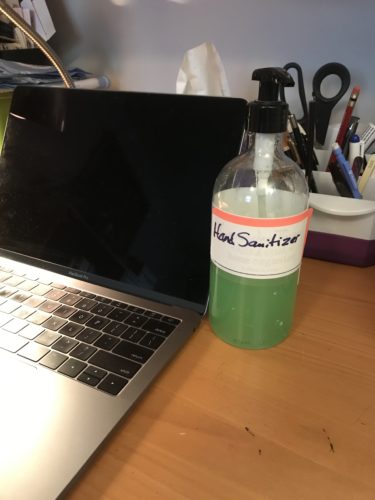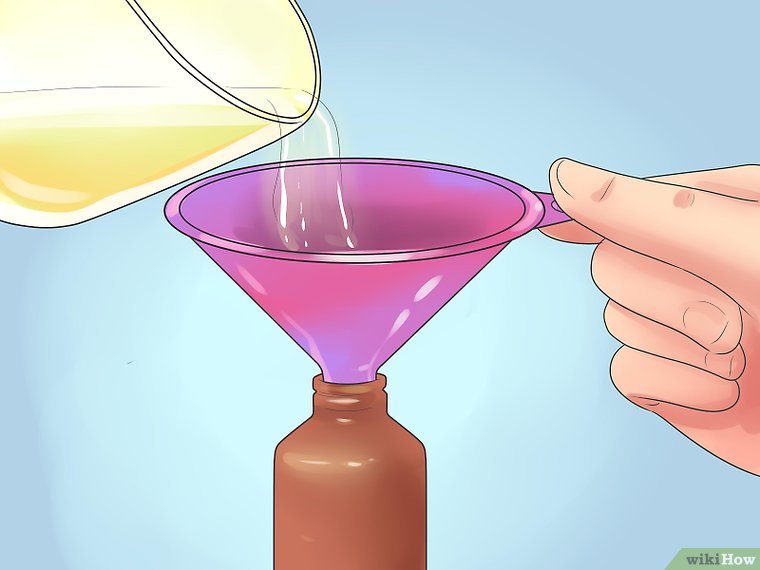
So, I was in my local supermarket the other day and I noticed that there was no hand sanitizer. I wondered how to make it myself. Of course, soap is a very effective measure against COVID-19/corona virus as it destroys the lipid membrane. But sometime you want a handy squirt as you’re nowhere near a sink. Turns out it’s not hard to make.
We have included a recipe for witch hazel-based hand sanitizer for people who can’t use alcohol. It’s worth noting that rubbing alcohol is usually 80 cents a small bottle but the shortages are pushing its price up. Witch hazel may be a more economical solution for your needs as well as being kinder to your hands. (We have supplied links to Amazon for most of the ingredients and containers. As there is a massive demand for rubbing alcohol you might want go troll your local pharmacies and dollar stores. I still found some in Safeway for under a dollar.)
Here are two types of hand sanitizer with helpful links to order the ingredients and equipment online.
Alcohol-Based Hand Sanitizer
This sanitizer closely resembles Purell. It’s not quite as chemically, and can smell better! To kill germs the strength of your hand sanitizer must be at least 60% alcohol. As we’re mixing with aloe vera we need to factor that in.
Here’s what you’ll need:
- 2/3 cup 99%* rubbing alcohol (isopropyl alcohol) rubbing alcohol (isopropyl alcohol) or 190-proof grain alcohol.
- 1/3 cup pure aloe vera gel (preferably without additives)
- 8 to 10 drops essential oil, such as lavender, clove, cinnamon, or peppermint
- Mixing bowl
- Spoon
- Funnel
- Plastic container (travel size and large pump size)
Mix the alcohol and aloe vera gel in the bowl until completely incorporated and smooth.
- If you want the solution to be thicker, add another spoonful of aloe vera.
- Or thin it out by adding another spoonful of alcohol.
Add the essential oil one drop at a time, stirring as you go. After about 8 drops, smell the mixture to see whether you like the scent. If it seems strong enough, stop there. If you like a stronger scent, add a few more drops.
- Lavender, clove, cinnamon and peppermint essential oils have the added benefit of providing additional antiseptic properties to the mixture.
- If you don’t like these scents, it’s fine to use whatever scent you enjoy. Lemon, grapefruit and passion fruit all work well.

Place the funnel over the mouth of your container and pour. Fill it to an inch from the top so it doesn’t overflow when you insert the pump. Screw on the travel container lid tightly until you’re ready to use it.
If you make too much for the bottle, save the leftover sanitizer in a jar with a tightly-fitted lid.
Witch Hazel-Based Hand Sanitizer
Some people prefer not to use alcohol in their hand sanitizer, for religious reason or because alcohol has a strong smell and can have a severe drying effect on skin. Using a witch-hazel based sanitizer is a great alternative. Witch hazel has been used to fight types of viral infections for millenia. Tea tree oil provides additional known antiseptic benefits.
Here’s what you’ll need.
- 1 cup pure aloe vera gel (preferably without additives)
- 1 1/2 teaspoons witch hazel
- 30 drops tea tree oil
- 5 drops essential oil, such as lavender or peppermint
- Mixing bowl
- Spoon
- Funnel
- Plastic container (travel and pump)
Stir together the aloe vera gel, tea tree oil and witch hazel. If the mixture seems too thin, add another spoonful of aloe vera to thicken it. If it’s too thick, add another spoonful of witch hazel.
Funnel the mixture into the container. Place the funnel over the mouth of the container and pour the hand sanitizer in. Fill it up, then screw on the lid until you’re ready to use it.
- A small squirt bottle works well if you want to carry the sanitizer with you throughout the day.
- If you make too much for the bottle, save the leftover sanitizer in a jar with a tightly-fitted lid.
*UPDATED: Why we recommend 70% isopropyl if using neat and 99% if mixing with aloe vera
From a Reader: To be effective, an alcohol-based hand sanitizer needs be at least 60% alcohol. Starting with 91% alcohol mixed 2:1 with aloe vera gel will produce an effective hand sanitizer of 60% alcohol.
From a medical standpoint, you need a certain percentage of water because ethyl alcohol kills bacteria mainly through two mechanisms: protein denaturation and dissolving the lipid membrane. So while a higher percentage should be better in theory, higher than 70% means too little water.
That’s because alcohol is hygroscopic, meaning it absorbs water. This will dehydrate and coagulate the bacterial cell wall, at least for some species. This coagulated cell wall seals up, preventing the alcohol from entering the inside of the bacterial cell so the bacteria can still be alive. Adding water (30% is the best trade-off based on experiments) has several effects. The dehydration and coagulation of the cell wall is slowed down so the alcohol has time to diffuse inside the bacterial cell and work on the proteins inside, killing it.
Also, 91% is very drying on skin. It removes all the natural oils, natural moisture [water] and all the other ‘good stuff’ that your skin has to protect itself. If you do use 91% neat on your skin it will dry out, turn gray and need to be re-moisturized.
There’s a great illustrated WikiHow article here from which we adapted this article. (https://www.wikihow.com/Make-Hand-Sanitizer). This material is available under a Creative Commons license http://creativecommons.org/licenses/by-nc-sa/3.0/.
